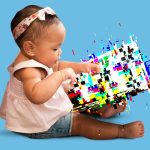I began this morning, as I do every morning, by reading my daughter a book. Today it was Arthur Dorros’ Abuela, illustrated by Elisa Kleven. Abuela is a sweet story about a girl who imagines that she and her grandmother leap into the sky and soar around New York City. Dorros does an elegant job weaving Spanish words and phrases throughout the text, often allowing readers to glean their meaning rather than translating them directly. When Rosalba, the bilingual granddaughter, discovers she can fly, she calls to her grandmother, “Ven, Abuela. Come, Abuela.” Her Spanish-speaking grandmother replies simply, “Sí, quiero volar.” Their language use reflects who they are—a move that plenty of authors who write for adults fail to make.
Abuela was one of my favorite books growing up, and it’s one of my 2-year-old’s favorites now. (And yes, we’re reading my worn old copy.) She loves the idea of a flying grandma; she loves learning bits of what she calls Fanish; she loves the bit when Rosalba and Abuela hitch a ride on an airplane, though she worries it might be too loud. Most of all, though, she loves Kleven’s warm yet antic illustrations, which capture urban life in nearly pointillist detail. Every page gives her myriad things to look for and gives us myriad things to discuss. (Where are the dogs? What does Rosalba’s tío sell in his store? Why is it scary when airplanes are loud?) I’ve probably read Abuela 200 times since we swiped it from my parents over the summer, and no two readings have been the same.
I don’t start all my days with books as rich as Abuela, though. Sometimes, my daughter chooses the books I wish she wouldn’t: ones that have wandered into our house as gifts, or in a big stack someone was giving away, and that I have yet to purge. These books have garish, unappealing computer-rendered art. Some of them have nursery rhymes as text, and the rest have inane rhymes that don’t quite add up to a story. One or two are Jewish holiday-oriented, and a couple more are tourist souvenirs. Not a single one of these books has a named author or illustrator. None of their publishers, all of which are quite small, responded to my requests for interviews, but I strongly suspect that these books were written and generated by AI—and that I’m not supposed to guess.
The maybe-AI book that has lasted the longest in our house is a badly illustrated Old MacDonald Has a Farm. Its animals are inconsistently pixelated around the edges; the pink circles on its farmer’s cheeks vary significantly in size from page to page, and his hands appear to have second thumbs instead of pinkies. All of these irregularities are signs of AI, according to the writer and illustrator Karen Ferreira, who runs an author coaching program called Children’s Book Mastery. On her program’s site, she warns that because AI cannot create a series of images using the same figures, it generates characters that are—even if only subtly—dissimilar from page to page. Noting this in our Old MacDonald, I checked to see whether it was copyrighted, because the US copyright office has ruled out copyright for images created by machine learning. Where other board books have copyright symbols and information—often the illustration and text copyright holders are different—this one reads only, “All rights reserved.” It’s unclear what these “rights” refer to, given that there is no named holder; it’s possible that the publisher is gesturing at the design, but equally possible that the statement is a decoy with no legal meaning.
What makes a good children’s book, and how much does it matter if a children’s book is good?
I have many objections to maybe-AI books like this one. They’re ugly, whereas all our other children’s books are whimsical, beautiful, or both. They aren’t playful or sly or surprising. Their prose has no rhythm, in contrast to, let’s say, Sandra Boynton’s Barnyard Dance! and Dinosaur Dance!, which have beats that inspire toddlers to leap up and perform. (The author-illustrator Mo Willems has said children’s books are “meant to be played, not just to be read.”) They don’t give my daughter much to notice or me much to riff on, which means she gets sick of them quickly. If she chooses one, she’s often done with it in under a minute. It gives me a vague sting of guilt to donate such uninspiring books, but I still do, since the only other option is the landfill. I imagine they’ll end up there anyway.
But I should admit that I also dislike the books that trigger my AI radar—that uncanny-valley tingle you get when something just seems inhuman—out of bias. I am a writer and translator, a person whose livelihood is entirely centered and dependent on living in a society that values human creativity, and just the thought of a children’s book generated by AI upsets me. Some months ago, I decided I wanted to know whether my bias was right. After all, there are legions of bad children’s books written and illustrated (or stock photo–collaged) by humans. Are those books meaningfully and demonstrably different from AI ones? If they are, how big a threat is AI to quality children’s publishing, and does it also threaten children’s learning? In a sense, my questions—not all of which are answerable—boil down to this: What makes a good children’s book, and how much does it matter if a children’s book is good?
I’m not the only one worried about this. My brother- and sister-in-law, proud Minnesotans, recently sent us a book called Count On Minnesota—state merch, precisely the sort of thing that’s set my AI alarms ringing in the past—whose publisher, Gibbs Smith, includes a warning on the back beside the copyright notice: “No part of this book may be used or reproduced in any manner for the purpose of training artificial intelligence technologies and systems.” Count On Minnesota is nearly wordless and has no named author, but the names of its artist and designer, Nicole LaRue and Brynn Evans, sit directly below the AI statement, reminding readers who will be harmed if Count On Minnesota gets scraped to train large vision models despite its copyright language.
In this sense, children’s literature is akin to the many, many other fields that generative AI threatens. There’s a danger that machines will take authors’ and illustrators’ jobs, and the data sets on which they were trained have already taken tremendous amounts of intellectual property. Larry Law, executive director of the Great Lakes Independent Booksellers Association, told me that his organization’s member stores are against AI-created books—and, as a matter of policy, refuse to stock anything they suspect or know was generated by a large language or vision model—because “as an association, we value artists and authors and publishers and fundamentally believe that AI steals from artists.” Still, Law and many of GLIBA’s members are comfortable using AI to streamline workflow. So are many publishers. Both corporate publishing houses and some reputable independent ones are at least beginning to use AI to create the marketing bibles called tip sheets and other internal sales documents. According to industry sources I spoke to on background, some corporate publishers are also testing large language and vision models’ capacities to create children’s books, but their attempts aren’t reaching the market. The illustrations aren’t good enough yet, and it’s still easier to have a human produce text than to make a person coach and edit a large language model.
“Kids are weird! They’re joyfully weird, and if you spend time with them and are able to get that weirdness and that playfulness out of them, you can really understand why a moralizing book really comes across as gross.”
Other publishers, meanwhile, are shying away. Dan Brewster, owner of Prologue Bookshop in Columbus, Ohio—a shop with an explicit anti-AI policy—told me, “The publisher partners we work with every day have not done anything to make me suspect them” of generating text or illustrations with AI; many, he added, have told him, “‘You’re never going to see that from us.’” (Whether that’s true, of course, remains to be seen.) In contrast, Brewster has grown more cautious in his acquisitions of self-published books and those released by very small independent presses. He sees these as higher AI risks, as does Timothy Otte, a co-owner and buyer at Minneapolis’ Wild Rumpus, a beloved 33-year-old children’s bookstore. Its legacy and reach, he says, means they “get both traditionally published authors and self-published authors reaching out asking you to stock their book. That was true before AI was in the picture. Now, some of those authors that are reaching out, it is clear that what they’re pitching to me was at least partly, if not entirely, generated by AI.”
Otte always says no, both on the grounds Law described and because the books are no good. The art often has not just inconsistencies, but errors: Rendering models aren’t great at getting the right number of toes on a paw. The text can be equally full of mistakes, as children’s librarian Sondra Eklund writes in a horrified blog post about acquiring a book about rabbits from children’s publisher Bold Kids, only to discover that she’d bought an AI book so carelessly produced that it informs readers that rabbits “can even make their own clothes…and can help you out with gardening.” (Reviews of Bold Kids’ hundreds of books on Amazon suggest that its rabbit book isn’t the only one with such issues. Bold Kids did not respond to repeated efforts to reach them for comment.) The text of more edited AI books, meanwhile, tends to condescend to young readers. Otte often sees books whose authors have “decided that there is a moral that they want to give to children, and they have asked a large language model to spit out a picture book that shows a kid coming up against some sort of problem and being given a moral solution.” In his experience, that isn’t what children want or how they learn. “Kids are weird!” Otte says. “They’re joyfully weird, and if you spend time with them and are able to get that weirdness and that playfulness out of them, you can really understand why a moralizing book really comes across as gross. The number of times I’ve seen kids make a stank face at a book that’s telling them how to be!”
AI could be no menace at all to picture-book classics, but it could make high-quality contemporary board books go extinct.
But is a lazy, moralizing AI book any worse than a lazy, moralizing one written by a person? When I put this question to Otte, the only distinction he could come up with was the “ancillary ethical concerns of water usage and the environmental impact that a large language model currently has.” Other book buyers, though, pointed out that while AI can imitate a particular writer or designer’s style or mash multiple perspectives together, it cannot have a point of view of its own. Plenty of big publishers create picture books and board books—which are simple, sturdy texts printed on cardstock heavy enough to be gnawed on by a teething 8-month-old—in-house, using stock photos and releasing them without an author’s name. Very rarely is the result much good, and yet each publisher does have its own visual signature. If you’re a millennial, you can likely close your eyes and summon the museum-text layout of the pages in a DK Eyewitness book. It’s idiosyncratic even if it’s not particularly special. To deny our children even that is to assume, in a sense, that they have no point of view: that they can’t tell one book from another and wouldn’t care if they could.
Frankly, though, I’m less concerned with the gap between bad AI and bad human than I am with the yawning chasm between bad AI and good human, since bad children’s books by humans are the ones more likely to become rarer or cease existing. If rendering models get good enough that corporate publishers stop asking humans to slap together, let’s say, stock-photo books about ducks, those books could, in theory, vanish. That doesn’t mean Robert McCloskey’s canonical, beautiful Make Way for Ducklings will go out of print. But it’s much less expensive to publish a book that was written years ago than it is to pay an author and illustrator for something new. It’s also less expensive to print a picture book like Make Way for Ducklings than a board book, with its heavier paper and nontoxic (again: gnawing baby) inks. AI could be no menace at all to picture-book classics, but it could make high-quality contemporary board books go extinct.
Only instinct and imagination can tell you what Sandra Boynton means when she writes in ‘Dinosaur Dance!’ that “Iguanodon goes dibbidy DAH.”
It doesn’t help that everyone from parents to publishers is susceptible to undervaluing board books. It’s very difficult to argue that the quality of a picture book doesn’t matter, since they are the ones that most children use to learn to read. But it’s easy to dismiss board books, which are intended for children not only too young to read, but too young to even follow a story. Can’t we just show a baby anything? According to Dr. John Hutton, a pediatrician and former children’s bookstore owner who researches the impact reading at home has on toddlers’ brain function and development, we shouldn’t. In fact, we should avoid reading our kids anything that bores us. Beginning in utero, one of the greatest benefits of shared reading is bonding, and unsurprisingly, Hutton has found that the more engaged parents are in the book they’ve chosen, the greater its impact on that front. But reading to babies is also important, he explained, because the more words a child hears, the greater their receptive and expressive vocabularies (that is, the words they know and can say) will be. This, starting around age 1, lets parents and children discuss the books they’re reading, a process that Hutton told me “builds social cognition and later dovetails with empathy.” It does this by training children’s brains to connect language to emotion—and to do so through imagination.
Hutton presented this as vital neurological work. “Nothing in the brain comes for free,” he told me, “and unless you practice empathy skills—connecting, getting along, feeling what others are feeling—you’re not going to have as well-developed neural infrastructure to be able to do that.” It’s also a social equalizer. Research has shown that reading aloud exposes children whose parents have lower income levels or educational backgrounds to more words and kinds of syntax than they might otherwise hear—and, Hutton notes, this isn’t a question of proper syntax. Rather, what matters here is creativity. Some of the best board books out there bend or even invent language—only instinct and imagination can tell you what Boynton means when she writes in Dinosaur Dance! that “Iguanodon goes dibbidy DAH”—and this teaches their little listeners how to do the same.
Of course, not all good board books’ strength is linguistic. Ideally, Hutton says, a book’s text and illustrations should “recruit both the language and visual parts of your brain to work together to understand what’s going on.” From ages 6 months to 18 months, my daughter was enamored with books from Camilla Reid and Ingela Arrhenius’ Peekaboo series, which have minimal text, cheery yet sophisticated illustrations, and a pop-up or slider on each page. My daughter loved it when I read Peekaboo Pumpkin to her, but she also loved learning to manipulate it herself. It was visually and tactilely appealing enough to become not just a book, but a toy—and it was sturdy enough to do so. She’s got plenty of other books with pop-ups, but Peekaboo Pumpkin and Peekaboo Lion are the only ones she hasn’t more or less destroyed.
Reid and Arrhenius publish with Nosy Crow, a London-based independent press. I reached out to ask if the company was concerned about AI threatening its business and got an emphatic no from its preschool publishing director and senior art director, Tor England and Zoë Gregory. England immediately highlighted the physical durability of Nosy Crow’s books. “We believe in a book as an object people want to own,” she said, rather than one meant to be disposable. They invest in them accordingly: England and Gregory visit Arrhenius in Sweden to discuss new ideas and often spend two or three years working on a book. Neither fears that AI could compete with the quality of such painstaking work, which, for the most part, is entirely analog. Some of Nosy Crow’s books do make sounds, though—something I generally hate, but I make an exception for the shockingly realistic toddler giggle in What’s That Noise? Meow! Gregory told me that while working on that book, she couldn’t find a laugh she liked in the sound libraries Nosy Crow normally uses, so she went home, set her iPhone to record, and tickled her daughter.
A good board book could become one more educational advantage that accrues disproportionately to the elite.
But somebody shopping on Amazon won’t hear that giggle. Nor can an online shopper identify a shoddily printed book, which may well be cheaper than Nosy Crow’s but will certainly withstand less tugging and chewing before it falls apart. A risk that Otte and the other buyers I spoke to identified—and while it serves booksellers’ interests to say this, it is also an entirely reasonable projection—is that while independent bookstores and well-curated libraries will continue to stock high-quality books like Nosy Crow’s, Amazon, which is both the largest book retailer and the largest self-publishing service in the nation, will grow ever fuller of AI dreck. If corporate publishers turn to AI to write and illustrate their board books, this strikes me as very likely to occur. It would mean that parents with the time and resources to browse in person would be likely to provide significantly higher-quality books to their pre-reading-age children than parents searching for “train book for toddlers” online. A good board book could become one more educational advantage that accrues disproportionately to the elite.
In Empire of AI, journalist Karen Hao writes that technology revolutions “promise to deliver progress [but have a] tendency instead to reverse it for people out of power, especially the most vulnerable.” She argues that this is “perhaps truer than ever for the moment we now find ourselves in with artificial intelligence.” The key word here is perhaps. As of now, AI children’s books are on the fringes of publishing. Large publishers can choose to keep them that way. Doing so would be a statement of conviction that the quality and humanity of children’s books matter, no matter how young the child in question is. When I asked Hutton, the pediatrician, what worried him most about AI books, he mentioned the example of “lazy writing” they set, which he fears might disincentivize both hard work and creativity. He also pointed to an often-cited MIT study showing that writing with ChatGPT dampened creativity and less fully activated the brain—that is, it’s bad for the authors, not just the readers. Then he said, “You know, there are things we can do versus things we should do as a society, and that’s where we struggle, I think.”
On this front, I hope to see no more struggle. We should not give our children, whose brains are vulnerable and malleable, books created by computers. We shouldn’t give them books created carelessly. That’s up to parents and teachers, yes—but it’s also up to authors, illustrators, designers, and publishers. Gregory told me that “there’s a lot of love and warmth and heart” that goes into the books she works on. Rejecting AI is a first step toward a landscape of children’s publishing where that’s always true.










